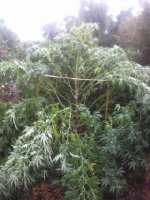dizzlekush
Member
The goal behind this thread is the create the best Plant Growth Regulator (PGR) regimen for my garden with the limited scientific prowess and knowledge i posses. Im going to attempt to keep it as simple as possible while also being scientific with my regimen building. The plan with each individual PGR is to start off with experiments to find optimum dosages for cannabis. Once the optimum dosage is quantified for the PGR, hopefully i add it to the regimen and then move on to the next PGR. I will not be testing PGR's that have potential toxicity issues. Some examples of these potentially toxic PGR's are the entire of PGR sub-class called the Growth Retardants (Paclobutrazol, Daminozide, Chlormequat Chloride etc).
I have many people to thank for the information that i have obtained. Thank you Spurr, OsWiZzLe/Storm Shadow, OldMan&theWeed and others for your knowledge and shared experience in the subject of medical marijuana friendly PGR's.
I will continue to update this post as experimentation continues.
Complications with Experimenting with Methyl DihydroJasomonate:
https://www.icmag.com/ic/showpost.php?p=4679530&postcount=9
https://www.icmag.com/ic/showpost.php?p=4693819&postcount=15
Triacontanol Experiment:
https://www.icmag.com/ic/showpost.php?p=4703675&postcount=19
Triacontanol Experiment Results:
https://www.icmag.com/ic/showpost.php?p=4788941&postcount=30
24-Epibrassinolide Experiment:
https://www.icmag.com/ic/showpost.php?p=4892527&postcount=35
https://www.icmag.com/ic/showpost.php?p=4939553&postcount=37
24-Epibrassinolide Experiment Results:
https://www.icmag.com/ic/showpost.php?p=5030601&postcount=49
I have many people to thank for the information that i have obtained. Thank you Spurr, OsWiZzLe/Storm Shadow, OldMan&theWeed and others for your knowledge and shared experience in the subject of medical marijuana friendly PGR's.

I will continue to update this post as experimentation continues.
Complications with Experimenting with Methyl DihydroJasomonate:
https://www.icmag.com/ic/showpost.php?p=4679530&postcount=9
https://www.icmag.com/ic/showpost.php?p=4693819&postcount=15
Triacontanol Experiment:
https://www.icmag.com/ic/showpost.php?p=4703675&postcount=19
Triacontanol Experiment Results:
https://www.icmag.com/ic/showpost.php?p=4788941&postcount=30
24-Epibrassinolide Experiment:
https://www.icmag.com/ic/showpost.php?p=4892527&postcount=35
https://www.icmag.com/ic/showpost.php?p=4939553&postcount=37
24-Epibrassinolide Experiment Results:
https://www.icmag.com/ic/showpost.php?p=5030601&postcount=49



